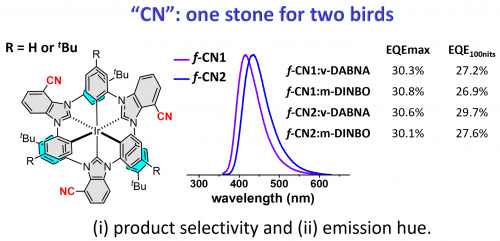M2 中村剛瑠君と笹部久宏准教授、城戸淳二教授らの青色リン光カルベンイリジウム錯体を用いた挟半値幅青色有機ELの国際共著論文が Chem. Eng. J. (IF: 15.1) に受理されました!中村、おめでとう!
本研究は、City University of Hong Kong の Prof. Yun Chi との国際共同研究です。本研究の一部は、JSPS 科研費(基盤研究B, 23H02032)の支援を受けたものです。
Abstract: Blue phosphors are indispensable in constructing organic light-emitting diodes (OLEDs). Herein, we reported two Ir(III) complexes, namely f-CN1 and f-CN2, with asymmetrically arranged benzo[d]imidazolylidenes, to which the peri-cyano substituent has concurrently induced both the selective aryl cyclometalation and emission tuning in giving one single blue Ir(III) phosphor. With the aforementioned ‘one stone for two birds’ tactics, these carbene complexes exhibited photoluminescent peak (λmax) at 472 nm and excellent quantum yields (83-100%) in doped thin films. Consequently, the fabricated OLED devices delivered maximum external quantum efficiencies (EQEmax) of 23.6% and 20.2%, respectively. Furthermore, hyper-OLED devices with f-CN1 and multi-resonant TADF terminal emitter m-DiNBO displayed an EQEmax of 30.8% with CIEx,y coordinates of (0.13, 0.10), together with impressive EQE of 26.9% at practical brightness of 100 cd m‒2.

